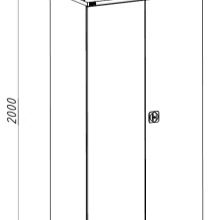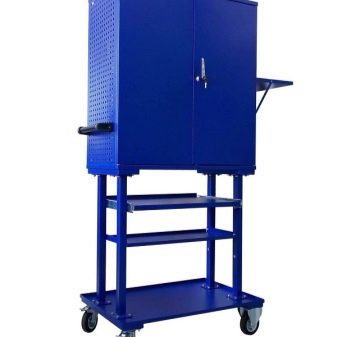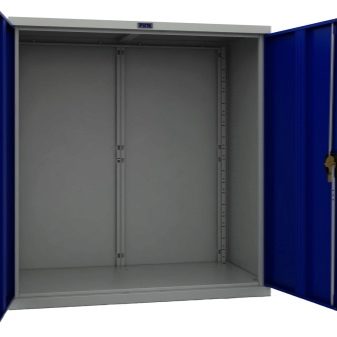Metal tool cabinets: model overview

A tool storage cabinet is a godsend for any craftsman. Having bought this kind of storage, you will always have the necessary tools in one place, that is, at hand. In addition, you can replenish the stock of personal tools with those devices that, due to the lack of a permanent and convenient storage place, did not dare to acquire earlier.
Appointment
A tool storage cabinet is a handy device designed to store tools in a workshop, garage or private home. The specially designed structure is able to withstand heavy loads. Due to this property, the scope of application of this type of cabinet is expanding. They can be installed in factories and other industries.
For this kind of storage, the following factors are characteristic that allow metal storage cabinets to be multifunctional:
- the ability to have access to tools and things;
- no restrictions on the use of equipment for this purpose;
- protection of inventory from unauthorized access by strangers;
- organization of the workplace and maintaining order.


Depending on the purpose and purpose of using the cabinet, its components may vary. Any completeness will affect the functionality and strength of the structure.
There is a wide variety of designs with parameters that determine their purpose and functionality. You always need to pay attention to all these factors, because thanks to them you will understand whether this or that model can fit into your room.
Varieties
Now many manufacturers of storage cabinets can boast of a variety of their products. This product is divided into several classifications according to the following criteria.
- Dimensions. The number of tools that can be stored in the cabinet depends on this parameter.



- Purpose and functionality. Depending on the purpose of the cabinet, its functionality will also depend. For example, in some cases, the mobility of the product is preferable, and in others, the method of fastening is fundamental.


- Components. This means many different departments or boxes. Depending on the tools and other devices that are supposed to be stored in the cabinet, its "filling" will also depend.



In total, experts identify several classifications of cabinets for inventory, depending on certain parameters. Let's take a look at each of the existing ones. You can distinguish between equipment for storing tools by the way it is used.
- For storing inventory. Such cabinets can be used as a place to store tools, appliances, fasteners, spare parts and other equipment. The design implies a strong frame that can withstand a fairly significant weight. Inside the cabinet there are special shelves, drawers, stands with hangers and many other devices to provide convenient and rational storage of inventory. Doors can be with locks or have special hinges for a padlock.
- Instrumental module. It involves a multifunctional structure that can be used not only for storing tools and other equipment, but also as a working area.For this, all drawers and shelves are located in the lower part of the structure, over which a solid metal tabletop is installed. Above the work table, many models are equipped with a special stand with hangers for smaller tools. Such a module is a very convenient place for a variety of work.


The next category of tool storage equipment differs in the degree of product mobility. There are two types of equipment.
- Mobile. Typically, this type of model is presented in the form of trolleys with many boxes. The main structural elements, thanks to which it becomes mobile, are the wheels. To make the product durable, manufacturers make trolleys with a rigid layout. To ensure safe movement and stability in the work area, handles and wheels with braking systems are installed on such equipment.
- Stationary. They mean strong metal structures that are installed on a flat floor surface or attached to a wall. From here it becomes clear that there are two types of stationary cabinets: floor-standing and wall-mounted. Floor standing usually have a solid construction with various accessories. Wall-mounted cabinets are designed for a lighter load compared to the floor-standing version. These restrictions are related to the weight of the equipment itself, fastening elements and the reliability of the wall on which such a cabinet will be installed.


As for the industrial models of cabinets, they can be divided according to the method of manufacturing the structure into the following main types.
- All-welded. The assembly takes place from steel sheets. It is carried out without a supporting frame. The elements of the product are fastened by continuous seam welding along the line of their joint. This technology is used to create stationary modules of low and medium load.
- National teams. Like the previous counterparts, products with such an assembly are made without using a supporting frame. Elements of the general structure are interconnected using various hardware.
- With supporting frame. This manufacturing method is only used to create the most robust tool cabinets. Such cabinets are based on a special power frame. It should be welded from shaped pipes and corners. The rest of the structural elements must be welded on top of the frame.



Thus, metal cabinets are the most durable, resistant to contact with an aggressive environment and convenient products for storing tools of any kind.
Design features
The existing tool cabinet models have different configurations of internal structural elements. Depending on the "stuffing" of the equipment, its functionality will also depend. There are two main design features of the cabinets.
- With vertical partitions. They have partitions that divide the inside of the cabinet into separate sections. Each section has several shelves.
- With one section. Equipped with a transom system. It is possible to rearrange the shelves at a convenient distance for the owner.


These types of cabinets can be equipped with various internal storage systems. Their configuration can consist of different elements:
- with drawers: movement is carried out using guide rollers;
- with shelves: can be located at different heights and at any distance from each other;
- with a perforated screen, the purpose of which is to fix various objects;
- with compartments of various sizes;
- with trays for small parts.
If among all the variety of cabinets it is still not possible to find a model with a suitable configuration, manufacturers can make a copy for an individual order.




Manufacturing materials
When it comes to storage cabinets, the material plays a key role. This kind of equipment can be made from three different materials, each of which has its own advantages and disadvantages.
- Metal (steel). It is considered the most common material for the manufacture of tool cabinets: it is durable, resistant to sudden changes in air temperature and humidity. The metal cabinet is usually made from steel sheets. For the case, a sheet with a thickness of 0.8 millimeters is used, and for shelves or drawers - up to 2 millimeters. To make the structure more durable and stable, a load-bearing structure frame is used.
- Wood (plywood). This option is usually used to create a cabinet for storing carpentry tools at home. Manufactured wood products are hard to find. They can only be made to order. This is due to the disadvantages of the material: increased sensitivity to changes in temperature and air humidity, as well as the need for constant processing.
- Chipboard (chipboard). Like the previous version, chipboard is used only for self-creation of a rack for carpentry tools. Locksmith tools can chip off the shelves. The strength of such a product will be low compared to a metal product.



Model overview
Much depends on the correct organization of the premises. A good choice and placement of a metal locksmith cabinet for storing tools will allow you to use its functionality to the maximum.
For a home workshop, it is best to purchase cabinets with many sections. Their volume should be quite large (for example, 210x104x50 cm). Such dimensions will allow you to accommodate all the necessary tools for various purposes and make the workflow comfortable.

For a production facility, it is recommended to choose medium-sized cabinets. Small storages (180x94x50 cm) may be the best option.


If you need to install such equipment within a house or apartment, then it is best to use wooden structures. In such conditions, they are not threatened by moisture and temperature drops. If there is a need to store electrical appliances, then you need an iron cabinet with parameters (100x100x50 cm) or any other small cabinet
Criterias of choice
The main criteria that many potential buyers are guided by when choosing a model of a metal tool cabinet are its technical parameters. When choosing a cabinet for storing tools, experts recommend paying attention to the following details.
- The size. If the room is small, then it is better to opt for a multi-sectional model.
- Massiveness. For storing carpentry tools, it is better to purchase an option, the carrying capacity of which will be up to 125 kilograms.
- Colour. In order not to disturb the harmony in the interior, it is better to take a responsible approach to the selection of cabinet colors.
- Strength. The thicker the steel sheets were used in the manufacture of the product, the stronger and more durable it will be. And also this criterion is influenced by the number of amplifiers in the product frame.
- Internal layout. Having a large number of compartments and drawers allows you to sort the storage items in the closet, but in this case, long or bulky instruments may not fit.

If you pay attention to the nuances listed above, then the selected model of the tool cabinet can perfectly fit into the workshop and serve for a very long period of time.
See below for an overview of metal tool cabinets.













The comment was sent successfully.